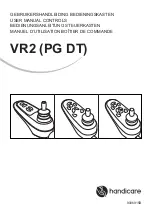
5
Using photocells for train detection
The photocells should be mounted between the rails in the
general area where you will locate the signal. Drill a 9/64"
hole through the ballast, roadbed, and sub-roadbed. For the
smaller scales this drilling may end up hitting the ties. Take
your time so you don’t mangle them! Figure 5 illustrates the
placement of a photocell in between the rails. Insert the leads
of the photocell into the hole from the top of your layout. One
of the photocell leads has a piece of insulation on it so be sure
the two leads don't touch each other! If the leads do not
Figure 5 – photocell placement
protrude enough from the underside of your layout then it will be necessary to extend the leads; soldering wires to them is the
most common method; make sure you insulate any connections you make to the photocell leads so that they don't short out.
Once you have wired the photocells to the
Grade Crossing Pro/2
and verified their operation you may wish to put a dab of
white glue under the photocell to hold it in place; make sure you don't get glue on the top surface of the photocell as this may
prevent it from operating properly. Figure 6 illustrates the photocell wiring; make sure you have the photocells in the correct
order as shown at the top of page 1. Photocells do not have any polarity so you can connect either lead to the GND terminal
and connect the remaining lead to the appropriate photocell input.
Photocells require a light source above them to
function properly. On most layouts the room
lighting should be sufficient. However, if the
photocells are located in an area that doesn't get
much overhead lighting or if you have simulated
"nighttime" operations then it will be necessary
to locate light sources on the layout near the
photocells. Streetlights and yard lights are
common light sources. Locate the light sources
slightly to the left or right of the photocells and
not directly over them; this will allow the
Grade
Crossing Pro/2
to still properly detect a train
that has stopped over any photocell with the gap
between cars over a photocell.
EN
EF
WN
WF
Figure 6 – Photocell wiring
Photocell sensitivity setup
You can adjust the sensitivity of each photocell on the circuit board using a small slotted head
screwdriver. Along one each of the board are four potentiometers (or “pots”) that are labeled
"WF", “WN”, “EN” and “EF”. The
Grade Crossing Pro/2
supports a SETUP mode to make
this adjustment process easier. To enable this mode, you must have the switch labeled SETUP
in the ON/CLOSED position as shown in Figure 7. In this mode the signals will not flash. The
Grade Crossing Pro/2
circuit board contains four sensor status LEDs; one near each of the four
adjustment pots. These LEDs will assist you in setting the photocell sensitivity.
Figure 7 - SETUP mode
Now follow these steps after you have connected power (see page 9) to the board:
1.
Remove all obstacles that may be covering the photocells or blocking overhead light to them.
2.
Insert the blade of the screwdriver (from the edge of the circuit board, not from the center of the board) into the
adjustment pots, one at a time. Turn the screwdriver completely counter-clockwise (left) in all FOUR of the pots.
3.
For the adjustment pot labeled WF turn the screwdriver clockwise (right) until the red LED near the pot just lights
up. Then turn the screwdriver back counter-clockwise until that LED goes out.
4.
Repeat step 3 for the three remaining pots with corresponding LEDs.
5.
Exit SETUP mode by putting the SETUP switch in the OFF/OPEN position (“operational” mode). The flashing and
other action should now operate properly. It may be necessary to repeat this procedure if layout lighting conditions
change significantly.
Note that the
Grade Crossing Pro/2
will activate the sensor status LEDs when the associated
sensor detects a train in “operational” mode; this is different from the previous generation
Grade Crossing Pro
!
Turning the pots clockwise adjusts for brighter overhead lighting conditions while turning the pots counter-clockwise
adjusts for dimmer overhead lighting.






























